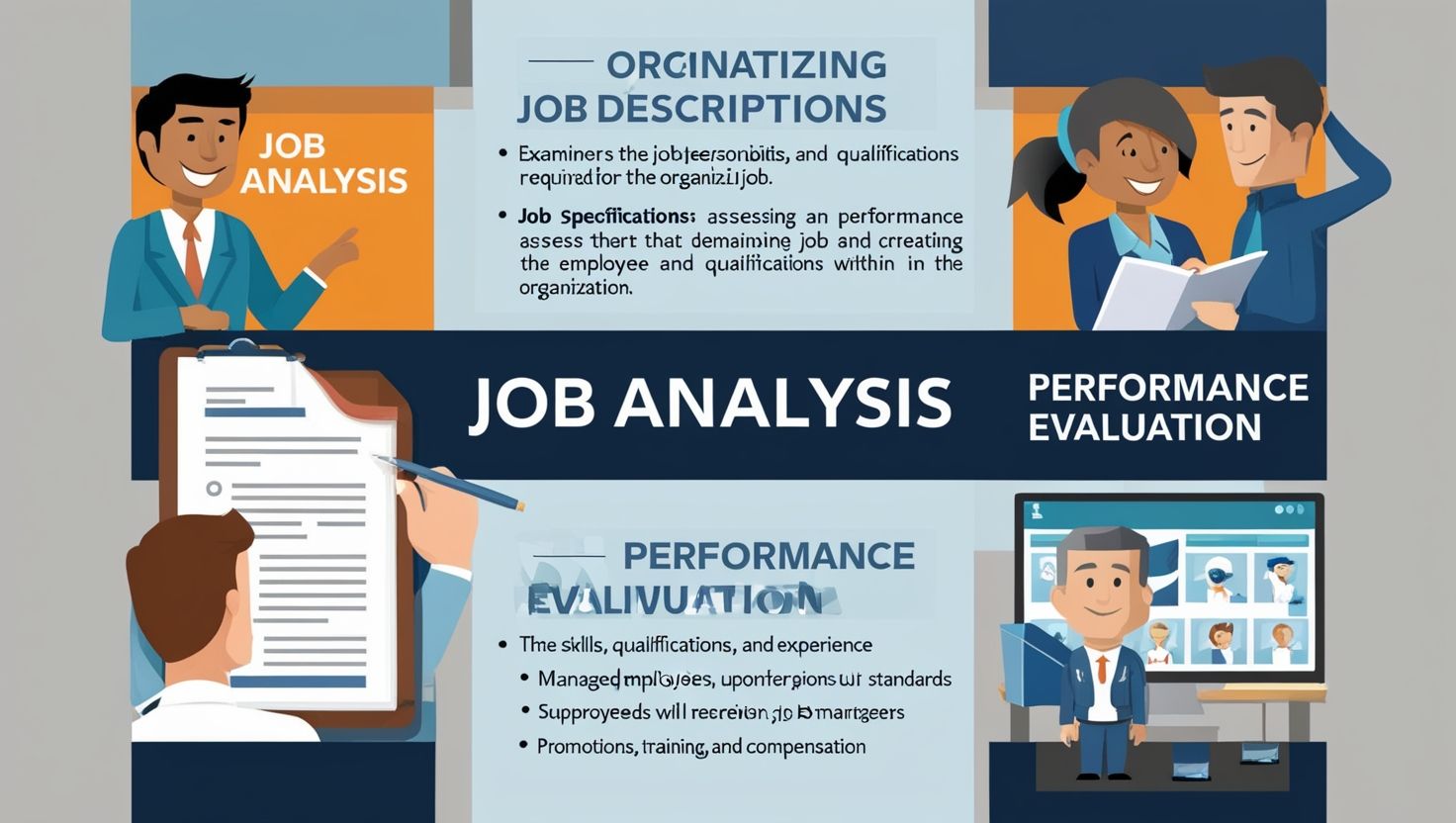Job analysis is a fundamental process in human resource management that serves as the foundation for various HR activities, including recruitment, training, performance management, and compensation. It involves gathering and analyzing information about the roles, responsibilities, qualifications, and performance standards required for a specific job within an organization. The three critical components of job analysis are Job Description, Job Specification, and Performance Evaluation. This article explores these components in detail and discusses their significance in the overall HR management process.
1. Job Description
A Job Description is a written statement that outlines the duties, responsibilities, and expectations associated with a specific role within an organization. It serves as a guide for both employees and employers, helping to set clear expectations about job performance and responsibilities.
Key Elements of a Job Description:
- Job Title: A clear and concise title that reflects the nature of the job. The title should be descriptive and easy to understand.
- Job Summary: A brief overview of the role, outlining its purpose within the organization. This section should capture the essence of the job.
- Duties and Responsibilities: A detailed list of the key tasks and functions associated with the role. These should be action-oriented and specific, such as “Prepare monthly financial reports” or “Supervise a team of 10 employees.”
- Working Conditions: Describes the environment in which the employee will work. This includes whether the job is performed in an office, factory, or outdoors, as well as any special conditions such as shift work, travel requirements, or the need for special safety equipment.
- Reporting Relationships: Clarifies to whom the employee will report (supervisor, manager, etc.), and any subordinates they may supervise.
- Job Location: Indicates the physical location where the job will be performed.
- Work Hours: Specifies the regular working hours, including any flexible work schedules or overtime expectations.
A well-crafted job description plays a critical role in the recruitment and selection process. It helps attract suitable candidates who are clear on the requirements and responsibilities of the job. It also assists in establishing a fair and transparent evaluation system, as both employees and employers will have a reference point for job expectations.
2. Job Specification
A Job Specification is closely related to the job description but focuses specifically on the qualifications, skills, experience, and attributes required for an individual to perform the job successfully. While a job description details the “what” of a job, the job specification outlines the “who” – the ideal candidate who would fit the job.
Key Elements of Job Specification:
- Educational Requirements: Specifies the minimum education level needed for the job. For example, a high school diploma, bachelor’s degree, or advanced degree may be required based on the nature of the job.
- Experience: Describes the amount of work experience needed to perform the job effectively. This can range from entry-level positions requiring little to no experience to senior roles demanding years of relevant industry experience.
- Skills: Lists both technical and soft skills needed for the job. Technical skills might include proficiency in software or machinery, while soft skills may involve communication, teamwork, and problem-solving abilities.
- Certifications and Licenses: For certain positions, specific certifications, licenses, or other qualifications may be required. For instance, an accountant may need a CPA license, or a healthcare provider may require medical certifications.
- Personal Characteristics: This section may detail personal attributes that contribute to job success, such as leadership qualities, attention to detail, or the ability to work under pressure.
- Physical and Mental Requirements: Some jobs may have physical demands, such as the ability to lift heavy objects, stand for long periods, or perform manual tasks. Mental requirements may include the ability to make decisions quickly, manage complex tasks, or handle stressful situations.
Job specifications ensure that the recruitment and selection process is aligned with the organization’s needs. They help in identifying and attracting candidates who possess the right qualifications and attributes to perform the job well. Moreover, they provide a basis for developing training programs to bridge any skill gaps.

3. Performance Evaluation
Performance evaluation is a systematic process of assessing an employee’s job performance. It typically involves setting performance standards, monitoring progress, and providing feedback to employees regarding their strengths and areas for improvement. The performance evaluation process is essential for maintaining an effective workforce, promoting employee development, and making decisions related to compensation, promotions, and training.
Key Elements of Performance Evaluation:
- Establishing Clear Performance Standards: Performance standards are criteria that define what successful performance looks like for a specific job. These standards should be clear, measurable, and aligned with the organization’s goals. They can be related to output, quality, efficiency, or other metrics depending on the role.
- Continuous Monitoring: Monitoring job performance throughout the year is critical for identifying issues early and ensuring that employees are on track to meet performance expectations. This can be done through regular check-ins, direct observation, and feedback from managers or colleagues.
- Performance Feedback: Providing employees with constructive feedback is an essential component of performance evaluation. Feedback should be timely, specific, and actionable. It should highlight both strengths and areas for improvement to help employees grow and develop professionally.
- Self-Assessment: Some organizations incorporate self-assessments into the performance evaluation process. This allows employees to reflect on their performance and contribute their perspective on their achievements and challenges.
- 360-Degree Feedback: In addition to supervisor evaluations, 360-degree feedback involves gathering input from peers, subordinates, and sometimes customers. This method provides a well-rounded perspective on the employee’s performance and behavior in the workplace.
- Rating Scales and Evaluation Tools: Many organizations use standardized rating scales or evaluation forms to assess employee performance. These tools often include categories such as quality of work, communication skills, teamwork, leadership abilities, and problem-solving skills.
- Performance Appraisals and Reviews: These are formal evaluations typically conducted annually or semi-annually. During these reviews, the manager and employee discuss the employee’s achievements, challenges, and career aspirations, setting new goals for the upcoming period.
Importance of Performance Evaluation:
- Employee Development: Performance evaluations help identify areas where employees may require additional training or development, contributing to their growth and job satisfaction.
- Recognition and Rewards: Regular performance reviews provide an opportunity to recognize top performers, offer promotions, or reward employees with bonuses, salary increases, or other incentives.
- Goal Alignment: Performance evaluations help align individual goals with organizational objectives, ensuring that employees understand how their work contributes to the company’s success.
- Decision-Making: Accurate performance evaluations provide the basis for HR decisions such as promotions, compensation adjustments, or even terminations.
4. Interrelationship between Job Description, Job Specification, and Performance Evaluation
The three components – job description, job specification, and performance evaluation – are closely interconnected and form the foundation of effective human resource management.
- Job Description provides a framework for the tasks an employee will perform, while the Job Specification details the qualifications needed to carry out these tasks. Together, they guide the recruitment and hiring process by helping employers find the right candidate.
- Performance Evaluation, on the other hand, helps measure whether an employee is fulfilling the expectations outlined in the job description and whether they possess the required skills outlined in the job specification. This process also provides feedback that can be used to adjust job descriptions or specifications if necessary.
Conclusion
Job Analysis, Description, Specification, and Performance Evaluation, Job analysis plays a critical role in managing human resources effectively. The development of comprehensive job descriptions, detailed job specifications, and robust performance evaluation systems ensures that organizations attract, retain, and develop the best talent. These elements not only enhance employee performance but also contribute to the overall strategic success of the organization. By ensuring clarity in roles, qualifications, and performance expectations, job analysis supports a productive and motivated workforce, leading to better organizational outcomes.

7 thoughts on “Job Analysis, Description, Specification, and Performance Evaluation”
Comments are closed.